Don’t let the name scare you off; this manifestation is far from insubstantial.
ThieAudio initially emerged as an IEM manufacturer, and I’ve been very impressed with some of their higher-end fare; the Monarch are still a favorite of mine. ThieAudio tried something new a few years back and released a planar magnetic, full-sized pair of headphones entitled the Phantom, which gained far less market recognition than their IEMs.
After 3-years of development, ThieAudio is back with the Wraith, another full-sized pair of headphones sporting a ghostly name. Featuring a new 97mm planar magnetic driver, ThieAudio is touting the “technical performance” and “enhanced tonal balance” of the Wraith “to suit the needs of professional audio engineers.”
- Exquisite all-metal build quality
- Comfortable
- 3 pairs of ear pads included to tailor the sound
- Non-fatiguing sound
- Well-made cable
- Easily modifiable to change the sound signature
- Severe sub-bass roll-off with stock pads
- 2.5mm ear cup sockets limit replacement cables
- Average resolution and technical performance
- Velcro ear pad mounting system sacrifices sound quality
Immediately apparent elements of the Wraith are the solid industrial design language and unique looks. The all-metal construction and black colorway boldly declare their serious intent. These are one of the better-looking pairs of planar magnetic headphones and are significantly superiorly constructed than some more popular brands.
It remains to be seen if the sound quality lives up to the bold claims and impressive construction.
The initial release of the Wraith included only one set of earpads. However, the version I received bundled in three distinct pairs intended to tailor the sound signature. I am unsure if this change was in response to constructive criticism or simple generosity, but more options are always better… right?
Are the new pads intended to ‘fix’ the sound, or is there something else going on?
Ruh-roh. It looks like we’ve got another mystery on our hands. Hop in the Mystery Machine and join the gang to get to the bottom of this caper. Let’s pull off the Wraith’s mask and see what’s happening.
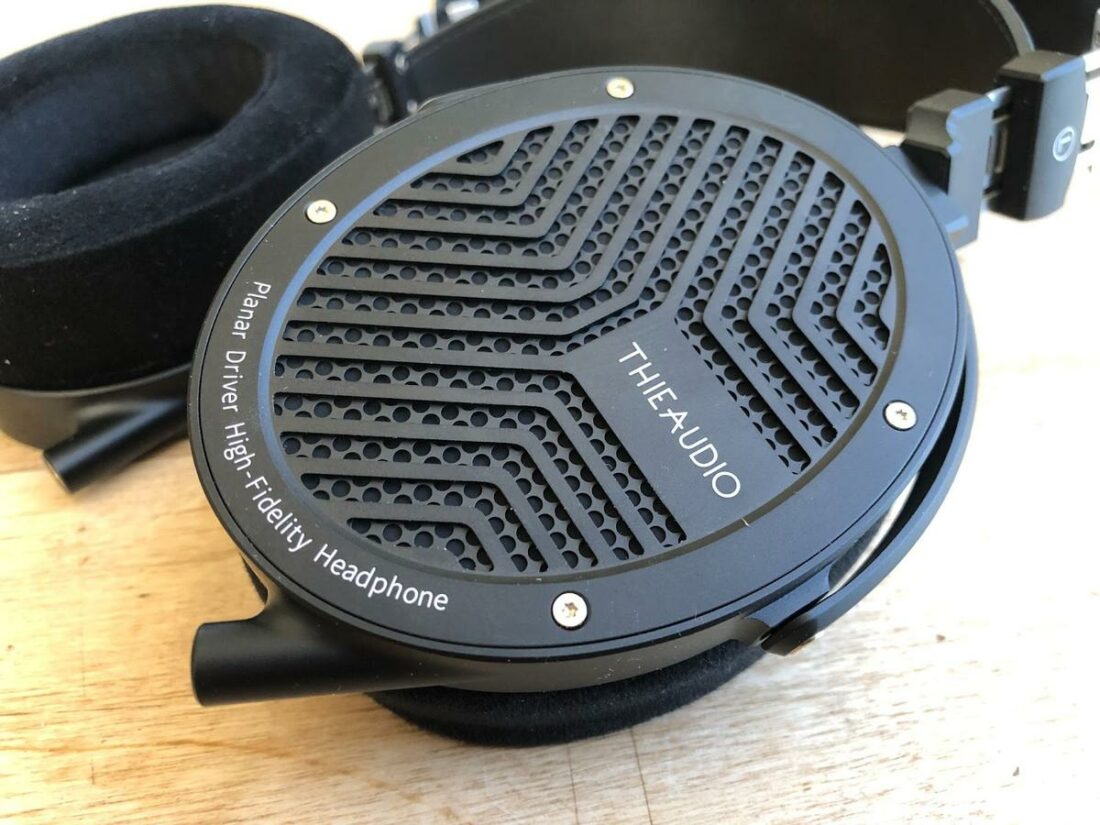
Company Overview
Thieaudio is a creative endeavor of Chi-Fi mega-retailer Linsoul Audio. Founded in 2019, the “…goal of Thieaudio was to serve as a creative platform for gathering the best teams of engineers … For each project, we hand-select the most innovative and renown [sic] engineers in his or her field to oversee the design, engineering, and manufacturing of the products.”
Technical Specifications
- Form: Open-back, over-ear
- Drivers: 97x76mm, planar magnetic, German conductor membrane
- Impedance (Ohm): 23Ω
- Sensitivity (dB): 101dB SPL/mW
- THD: <0.8%
- Frequency Response (Hz): 20Hz-40kHz
- Removable Cable: Y, 1.25m, OFC, coaxial shielded
- Source Jack: 4.4mm, balanced
- Cup/Shell Jack: 2.5mm
- Weight (g): 455g without cable
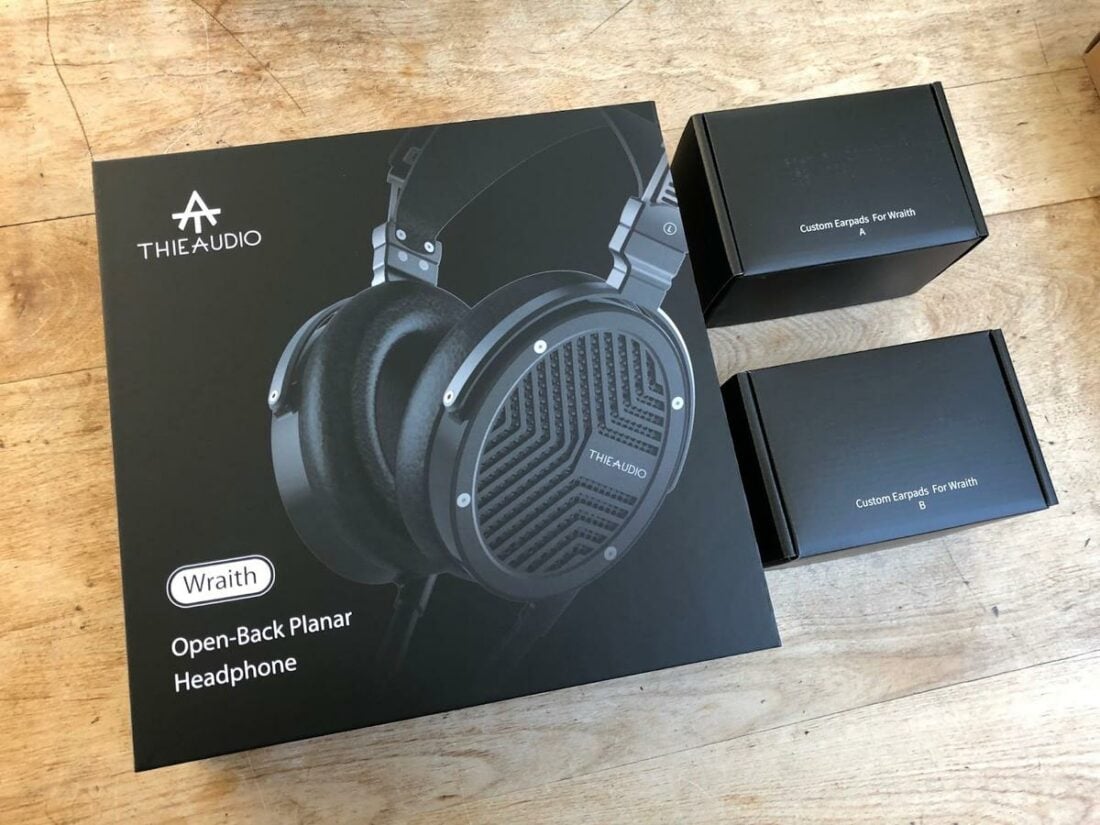
Packaging
The Wraith come in an attractive cardboard box with the product image on the front, highlighted with white text. Two smaller boxes labeled “Custom Earpads for Wraith” “A” and “B” are included with the set.
Inside the box, the Wraith and cable are nestled neatly in a foam insert. An engraved serial number plate is featured the center. A large instruction booklet rounds out the package.
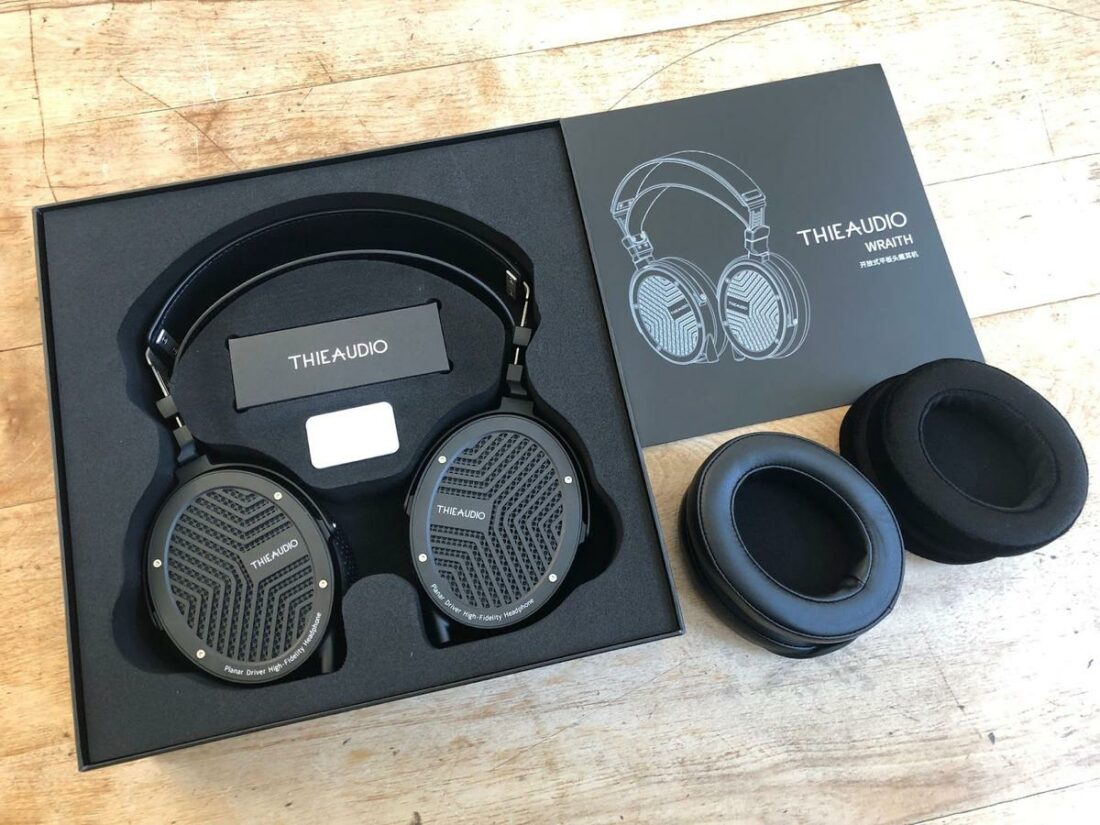
In the box
- Wraith headphones
- Perforated leather ear pads (installed)
- Smooth leather ear pads (Custom Earpads for Wraith A)
- Smooth velvet ear pads (Custom Earpads for Wraith B)
- 2×2.5mm to 4.4mm balanced cable (1.25m)
- User manual
- Serial number plate
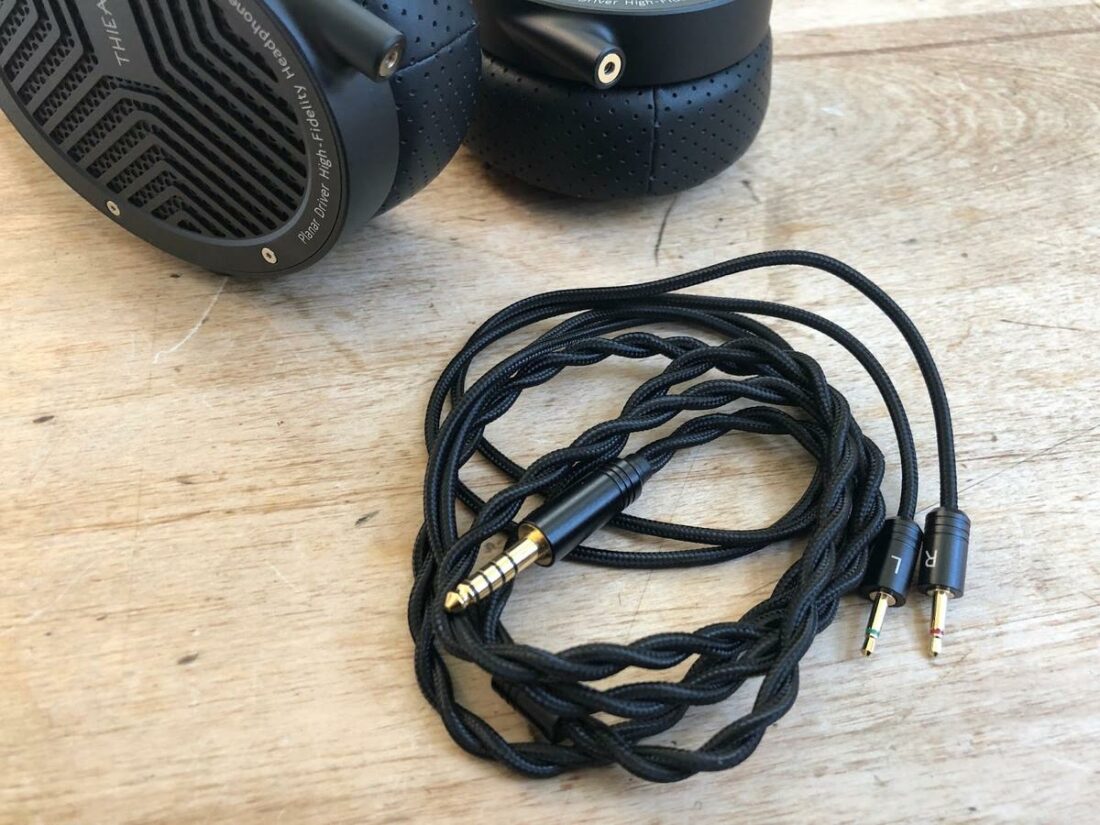
Cable
While some will lament the 2.5mm connectors on the ear cups, a choice rarely seen outside Chinese brands such as Sivga/Sendy Audio these days, I have little concern regarding their longevity. The cable seems exceptionally well-made, and the machined sockets on the headphones themselves will not be an issue.
The 1.25m OFC cable is wrapped in black fabric and thin enough to be supple and easily manipulated. The individual cords from each ear cup combine into a simple wrapped braid to the 4.4mm metal plug.
The cable’s understated looks and impeccable construction perfectly match the Wraith.

Design
The Wraith make the plastic construction from the likes of HiFiMAN look like mere toys in comparison. The cups are immaculately machined from solid aluminum and feature an attractive vent pattern on the outside.
The black metal yokes attach via a full 180-degree swivel to a leather-wrapped band and adjustable comfort suspension strap. It’s an innovative, solid, and sturdy design that works well and should survive rough treatment.
Seriously, the Wraith look and feel superior to headphones many times their price.
The attached leather pads are perforated around the inner and outer sides, while the upper surface is smooth. The two additional pads are entirely smooth; one made of leather and the other of velvet. To paraphrase Henry Ford, you can have any color you want, as long as it’s black.
Velcro rings attach the pads around the inside of the cup and on the bottom of the pads themselves. Easy to remove and swap, but as we will discuss later, this mounting mechanism does impact the sound.
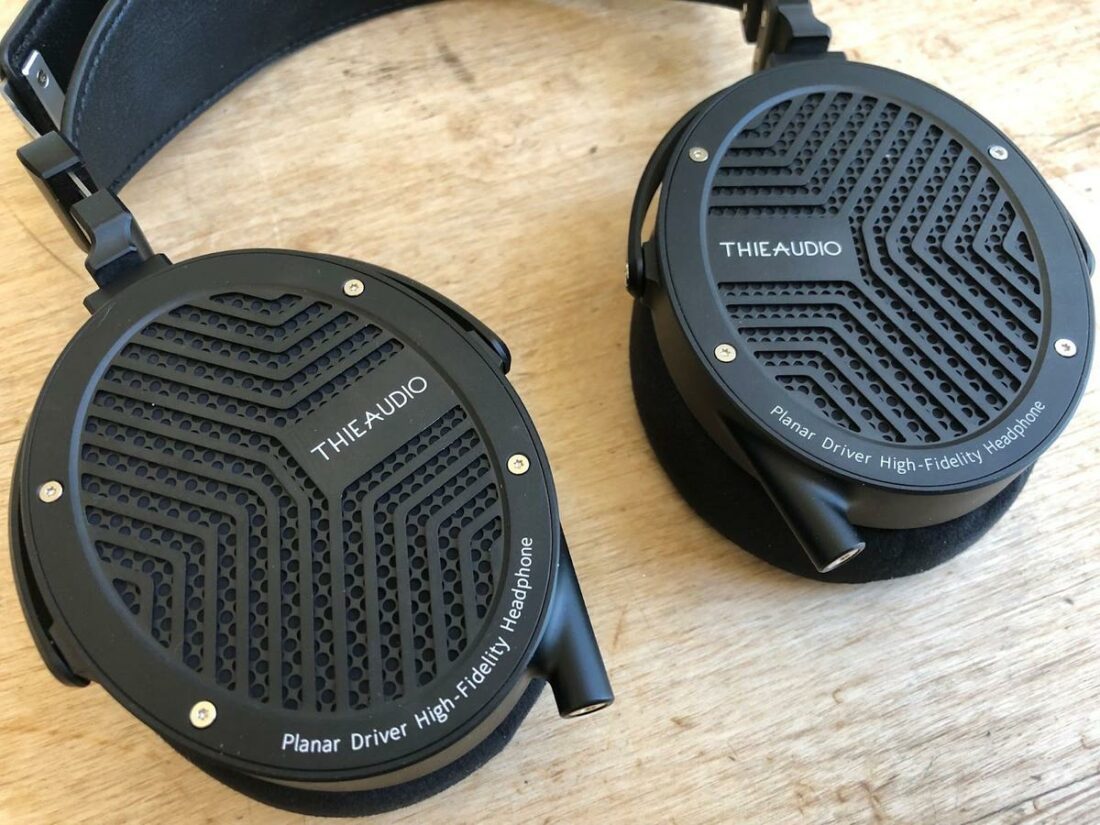
Comfort
But surely the all-metal construction means that the Wraith are far too heavy? High weight is a common complaint with many pairs of planar magnetic headphones. Often comfort is compromised, even when lighter-weight materials such as wood, carbon fiber, and plastic are used for construction.
I’m happy to report that the cracking comfort strap and well-upholstered pads are more than up to the task of taming the nearly 450g weight of the Wraith. The clamping force is moderate, and the Wraith fit and seal around my ears properly on my medium-large-sized noggin.
While the pads don’t appear large, they are spacious inside and easily contain my average-sized ears. All the ear pads seem stuffed with the same soft non-memory foam.
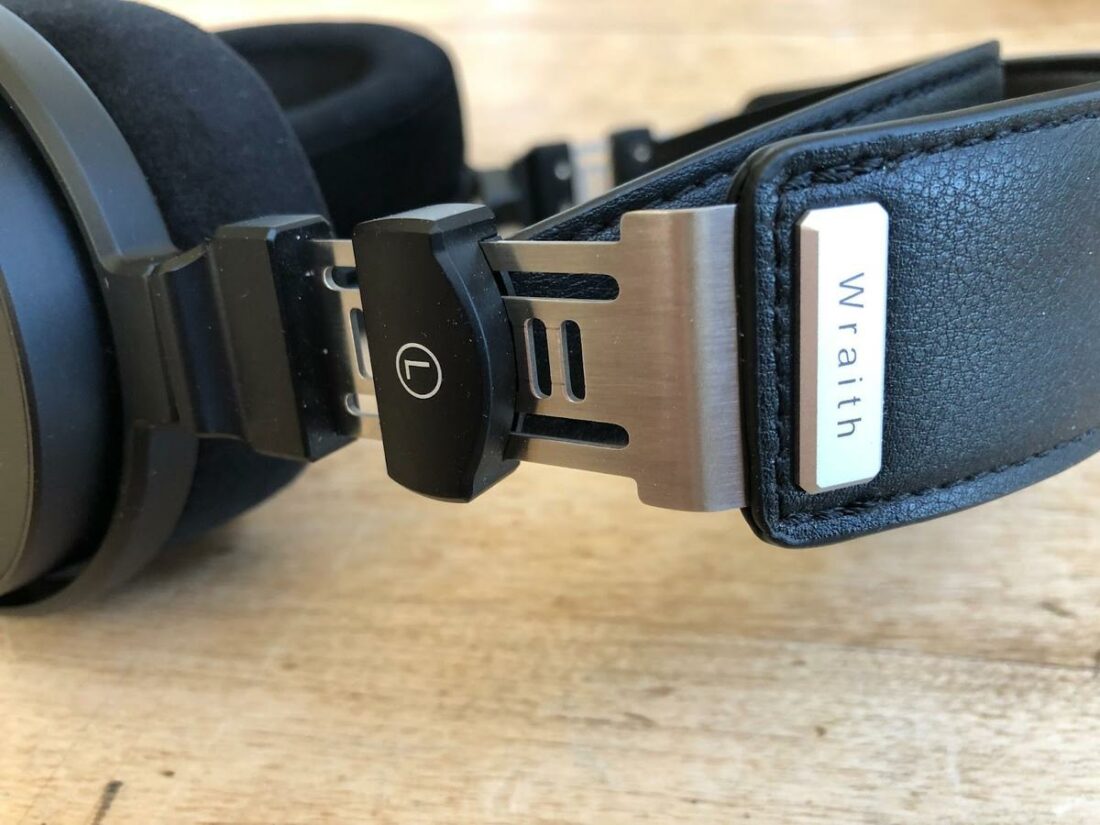
Internals
The Wraith contain ThieAudio’s new 97mm planar magnetic drivers – the Phantom used larger 101mm planar magnetic drivers. These updated drivers are described as having a thinner German conductor membrane with more uniform surface tension, a structural airflow design, and a 1.5x stronger magnetic field.
Efficiency is relatively high for a planar magnetic pair of headphones, with an impedance of 23 Ohms and sensitivity of 101 dB/mW. While many portable devices can drive the Wraith, planar magnetic headphones benefit from high current sources. To sound their best, the Wraith are better suited for desktop or very robust portable amplification.
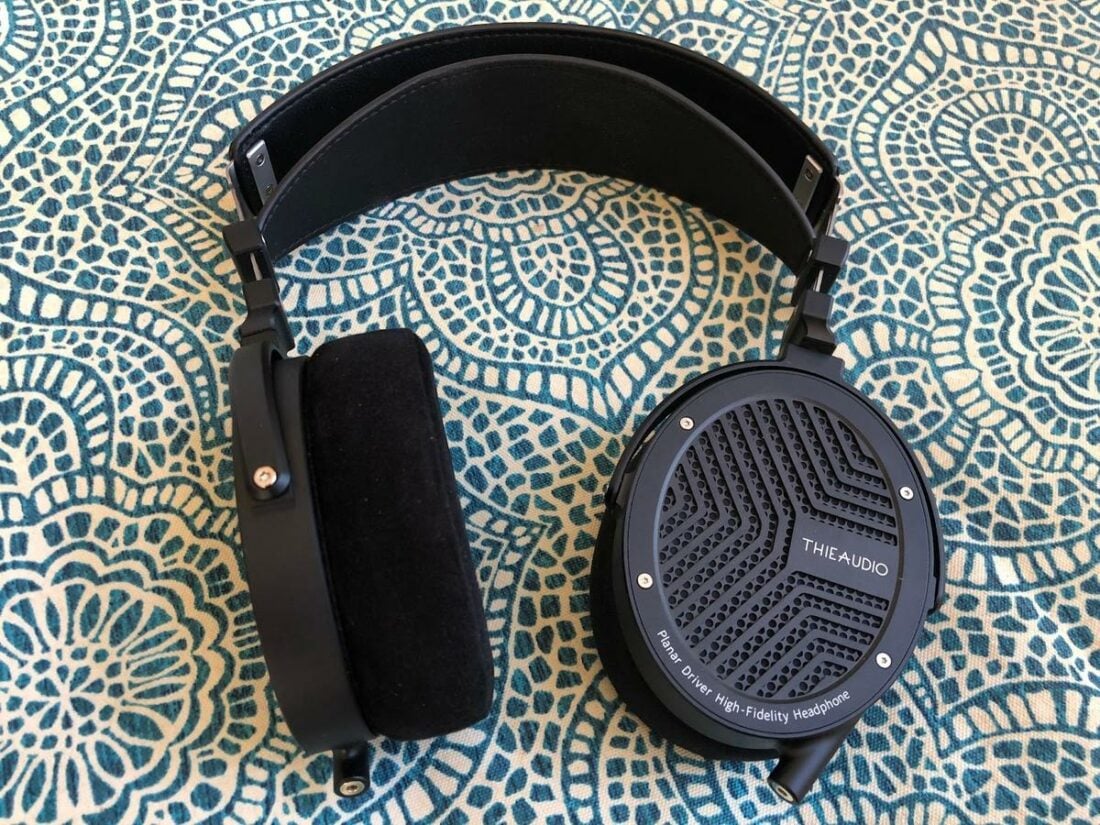
ThieAudio Wraith Sound
Although the Wraith are billed as having an enhanced tuning balance intended to suit professional studio engineers, the reality is different from what I expected from those claims.
The Wraith are colored and warm-sounding out of the box but are missing a lot of sub-bass presence.
Studio use often refers to a flat signature. While the mid-bass is somewhat boosted, the Wraith don’t follow a typical planar ruler-flat frequency response curve into the lower registers and have a prominent roll-off.
This isn’t to say they are unpleasant to listen to, and the Wraith give a laid-back listening experience that seems to do better with jazz and folk music rather than high-energy EDM or rock. In stock form, they certainly provide a different sonic flavor than other planar-magnetic headphones in this price range.
Resolution and detail presentation are about average, and the Wraith don’t seem suited for truly critical listening (again, bringing the intended ‘monitoring’ usage into question). You’ll likely be drawn to or repelled by their unique presentation, and the Wraith are bound to be divisive among listeners.
The soundstage is quite intimate, and although the instruments and performers seem close, the overall sound has softer edges, and overall dynamics seem a little muted.
These are easy headphones to listen to and relax. Some headphones grab me by the ears and force my attention, while others allow for a relaxing chill session. The Wraith are firmly in the latter camp.
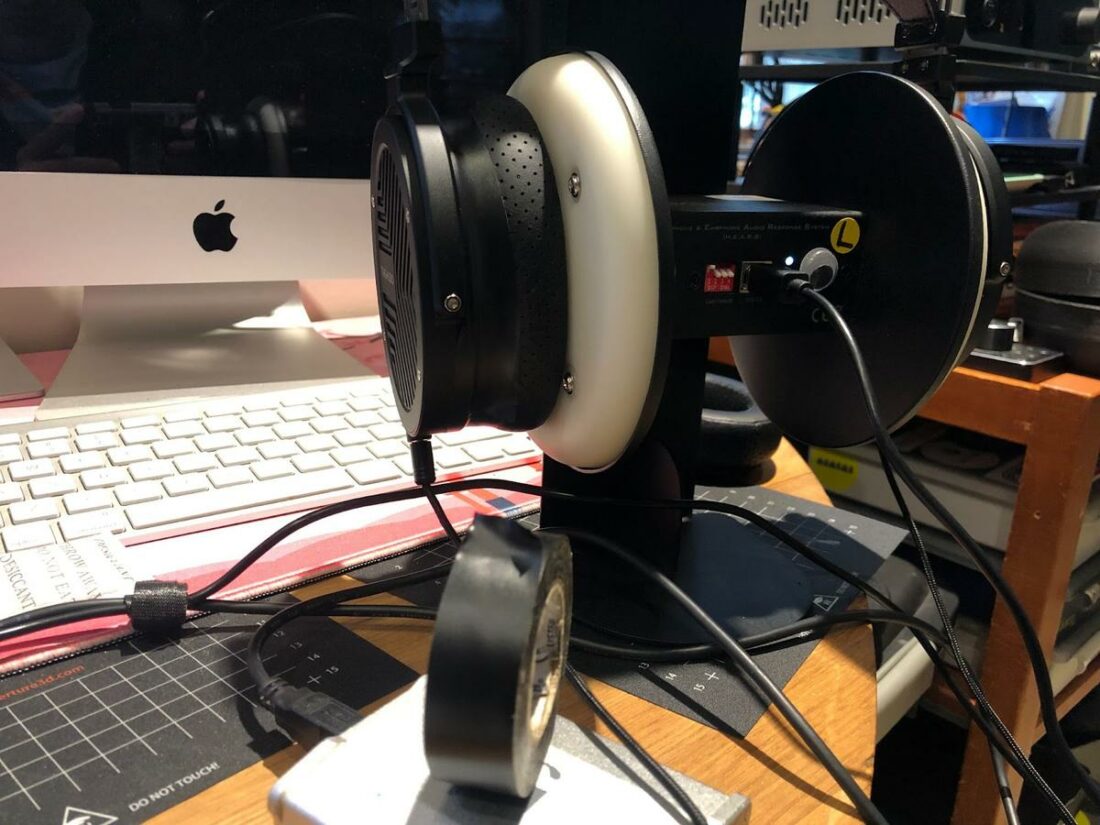
Bass
I appreciate planar magnetic headphones because of their typically flat bass response, which can descend linearly into the lowest registers. Not so with the Wraith. Below 80Hz or so, the bass response quickly disappears. Above that, there is a moderate mid-bass peak.
This tuning seems to have resulted in quick and reasonably textured bass reproduction, but it doesn’t quite create the visceral experience I usually enjoy from planars. The Wraith feel overly dampened down, perhaps in an effort to achieve the “studio sound” that ThieAudio claims they were trying to achieve. Regardless, it’s an odd tuning for a planar headphone.
Electronic music especially seems toned down by the Wraith, with the biggest and deepest hits almost missing. If your tastes run to genres that rely on mid-bass kick, you’ll find decent detail there, but it still seems a bit subdued.
Midrange
The midrange benefits from the leaner lower registers as there is plenty of space to be articulate and clear. The mids come across as a touch forward, and that mid-bass presence translates to a slightly warm signature.
The upper mids are more laid back than I’ve encountered in other planar magnetic headphones around this price range. I appreciate the subtler approach, as voices and instruments anchored here sound natural and genuine. Overly aggressive 3kHz peaks can sound nasal and harsh to my ears.
Treble
Unlike the lower frequencies, the treble is well extended with plenty of air above 7kHz and no overt audible spikes. There is good detail presentation, and the Wraith manage to avoid harshness or sibilance.
I have little to complain (or talk) about in this frequency range, and while not spectacular, the treble response is very competent.
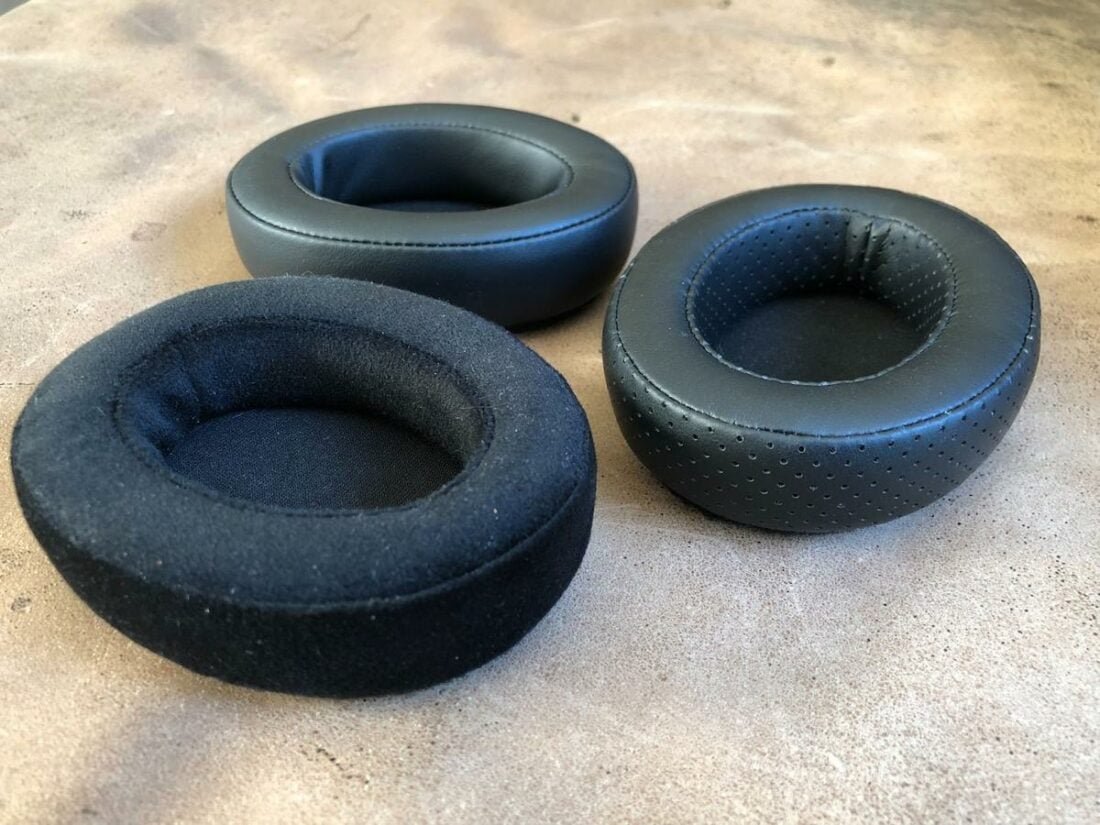
Pad Swapping and Modification
Well, gee Trav, you seem a bit harsh on the Wraith.
To be fair, from the first moment I encountered them, I was wowed by how these headphones looked and how they felt. My eyes set expectations for their sound, and yes, I was a bit let down on the first listen. I had high hopes.
But all is not lost.
After extended listening, it seems obvious why ThieAudio included a couple of additional sets of pads in the current package. Undoubtedly, early feedback suggested that listeners would like to tweak the sonics, and pads are the most effective and inexpensive way to do so.
The leather and velvet pads significantly change the sound of the Wraith.
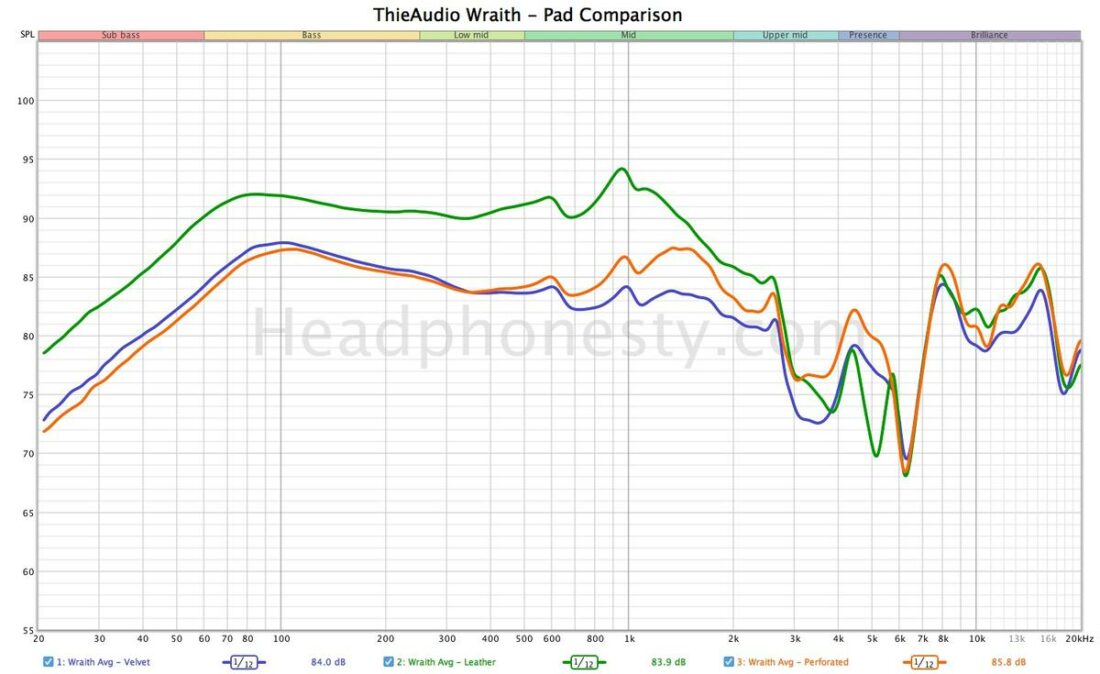
The velvet pads are my favorites of the three, as they smooth out that super prominent 80Hz-1kHz range of the original ear pads. Coupled with a lower 3-5kHz range breathes a little air and brightness and makes the overall signature far more balanced.
The leather pads track much more closely to the velvet pads than the perforated originals but with a higher midrange presence than the velvet offers. Some folks like a lot of upper midrange presence, but I like this area toned down in the mix.
Removing the Velcro
On paper, Velcro seems like it should be a terrific method of attaching ear pads. It holds firmly but is easily removable innumerable times. In fact, it made pad swaps and comparisons super easy.
But Velcro does not make a seal – it easily lets air pass through and limits bass extension.
This is a huge compromise (and flaw) in the Wraith’s otherwise smart design.
I wanted to test this theory easily, so the first step was quick and dirty. I wrapped black electrical tape around the exterior seam between the ear cups and velvet pads. The measurements speak for themselves, but if the squiggles are all… well, just squiggles to you, let me elaborate.
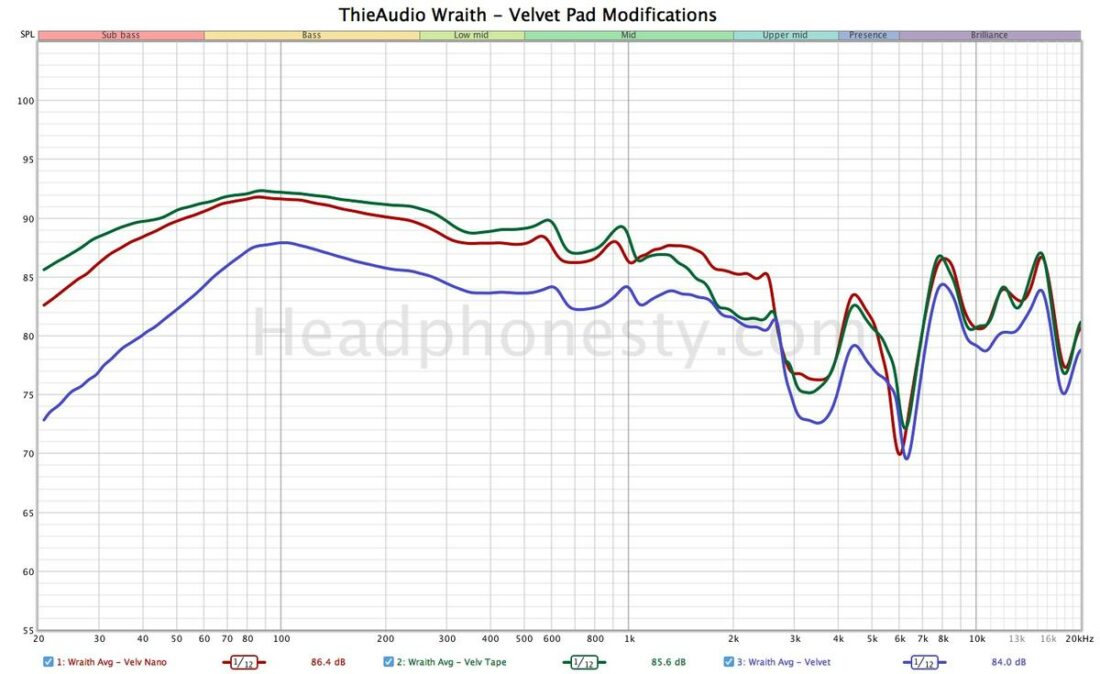
The tape seal results in approximately a 5dB gain from 80Hz to 3kHz. Under 80Hz, that rolled-off section is boosted by about 10dB. Halleluiah!
However, I’m not a guy who is satisfied with a janky solution of tape wrapped around otherwise beautiful headphones. So, I tackled the problem head-on and peeled the Velcro out from inside the cups. Easy enough.
I then cut a thin (5mm) strip of clear double-sided Nano tape (excellent stuff) and created a sticky strip where the Velcro was previously mounted.
Press the velvet pads back in, and they hold snugly. The audible result is similar to the electrical tape wrap, with the most significant change being an elevation between 1-2.5kHz. Enough to add some energy but not cross the line into nasal-ness. Lessening the bass roll-off is a huge win.
Ultimately, this is how the Wraith should come out of the box. ThieAudio, please drop the Velcro fasteners immediately. Admittedly, this tuning moves the Wraith further from studio flatness, but the elevated bass and midrange make them FAR more entertaining.
Removing the Velcro transforms the Wraith into something much more visceral and exciting.
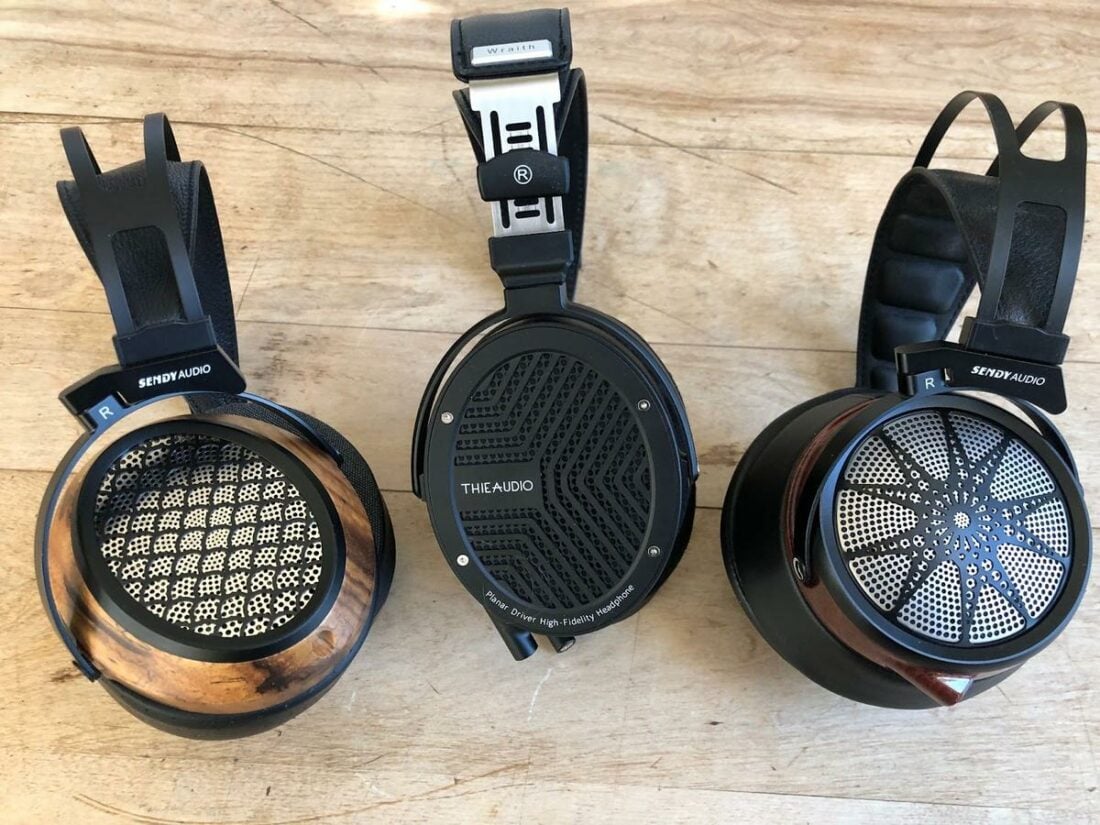
Comparisons
Other planar magnetic headphones priced right around USD$500 include the HiFiMAN Edition XS (likely the current bang-for-the-buck king) and Sendy Audio Apollo and Aiva.
While the XS are arguably the better sounding, the Wraith is far better constructed, with superior materials, robustness, and comfort. However, out of the box, the XS win with terrific resolution and clarity, not to mention far more sub-bass response. The XS are excellent with a wide variety of music styles.
The comparison with Sendy Audio’s similarly priced planar magnetic headphones is interesting. For one, the driver in the Aiva (shared with the Takstar HF 580, Monolith 570, and Blon B20) is 97mm x 76mm in size – the exact dimensions as the Wraith driver.
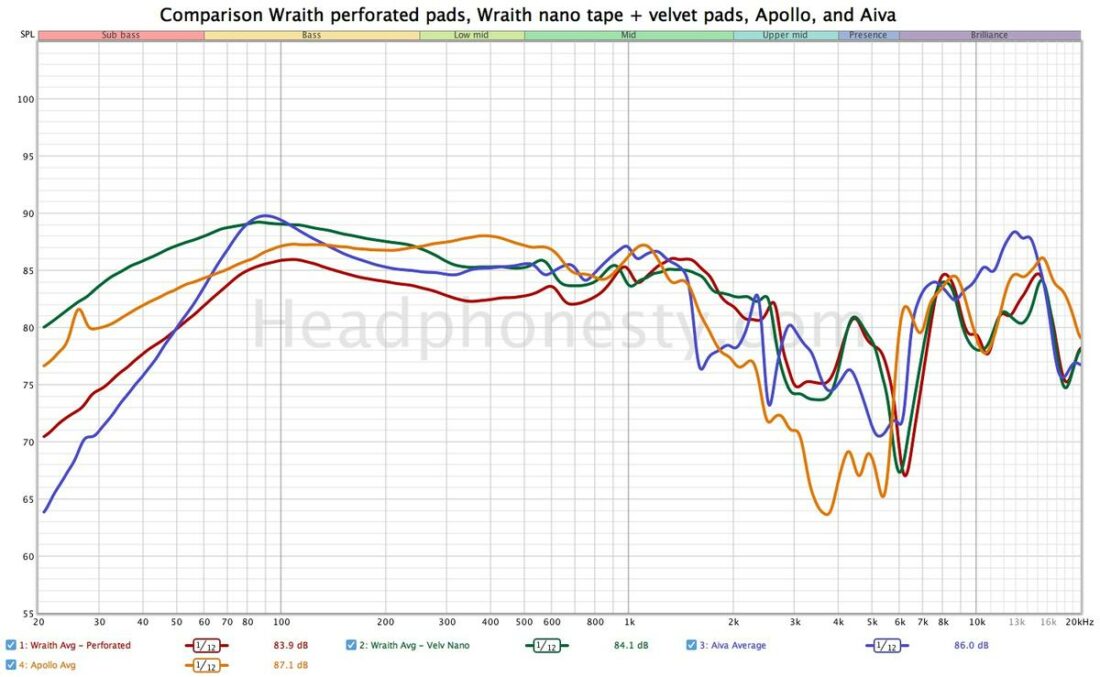
The Aiva also share a similar (if even more pronounced) extreme bass roll-off around 90 Hz. In fact, the entire frequency response is alike. Draw what conclusions you may.
The Apollo and modified Wraith are somewhat comparable sounding, although the Apollo has a very scooped-out upper midrange presence area. If you are a fan of these Sendy Audio headphones, with a bit of easy tinkering, you can modify the Wraith into approximations of both.
Although, I have to say the Wraith are superior sounding than either of the Sendy Audio headphones.
Both the Sendy and ThieAudio headphones are very well-made and comfortable. Aesthetically they diverge, with Sendy favoring wooden construction vs. the all-metal Wraith. Both designs are beautiful in their way.
Where to Buy
Conclusion
The Wraith are a near-great pair of headphones, hampered by an (easy to remedy) design flaw. Out of the box, their beautiful industrial looks and terrific build quality set high expectations. Couple that with ThieAudio’s bold marketing claims, and the sound quality has massive shoes to fill.
Sure, the stock pads look and feel great, but they create an odd sound profile. Adding a couple of extra pad options helps things, but removing something small is the best way to improve the Wraith.
Who knew Velcro could be so pernicious?
Once the pads seal better with the cups, the sub-bass roll-off is lessened, and the sound signature becomes more balanced. The stock tuning works well enough with genres that often eschew the lowest bass tones, such as Jazz or Folk music, but the modified Wraith is a far improved all-rounder with a greater variety of musical styles.
With other excellent contenders around this price point, giving the Wraith a strong recommendation is difficult. What they do well, they do extremely well, but that darn HiFiMAN XS is such a strong competitor in sound quality. If you have the chance, try them both, and you may find the unique sonic flavor of the Wraith wins you over.
